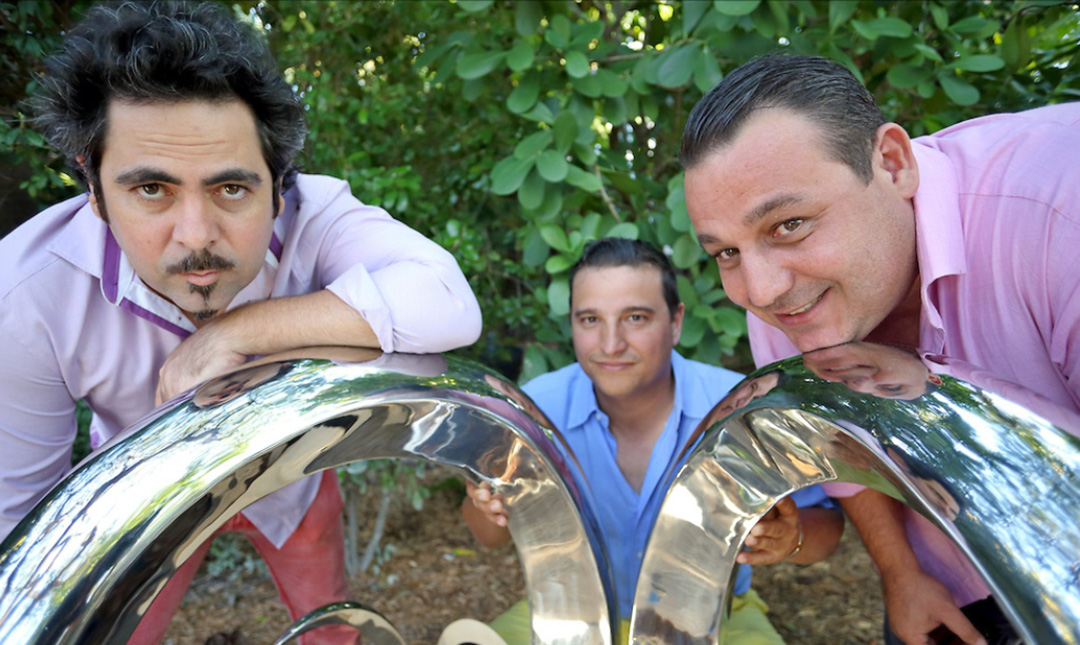by Nila Do Simon | June 27, 2018
Inside the Studio with The Merger
A pair of Cuban artists with South Florida ties prove that the creative process is better together
In the balmy, humid climate of Havana, Cuba, contemporary art springs from the hearts and hands of passionate artists making statements as political as they are visually striking. Amid the tropical environment and dynamic culture that Americans are slowly coming to know as tensions with Cuba continue to ease, a talented duo turns out works that show the rest of the world what modern-day Cuban art is about.
The-Merger is an arts collective founded by childhood friends Niels Moleiro and Mario Miguel “Mayito” Gonzalez. They’ve been quietly creating thought-provoking, multilayered sculptures since 2009, and in less than a decade, The-Merger has surfaced as a leader in Cuba’s contemporary art scene. The artists have been featured in The Wall Street Journal, raked in $187,500 at a recent Sotheby’s auction, and even count Beyonce as a collector of their work.


Originally a trio, formed by Moleiro and Gonzalez with fellow artist Alain Pino, The-Merger began with the idea that two or three heads are better than one. Moleiro and Gonzalez, self-taught artists who delve wholeheartedly into their craft, had their own careers when Moleiro suggested they collaborate. For Moleiro, a part-time Miami resident, the advantages of teaming up were obvious: “Together we can do greater things, and more things happen than when we work alone,” he says through a translator. “For example, if there’s a rock, we both can polish it better than one person can alone. With our art, we just polish and polish and polish until we come to an agreement on what we should create.”


Their work often comes in the form of a sculpture that tells a story, whether it’s a tale about the political climate in Cuba (Against the Tide depicts a swimmer finding the strength for one more stroke atop a silhouette of the island) or something more personal. The stainless steel sculpture El Caso de la Rubia Platino (Menina) is an abstract work that showcases a young girl with an innocent countenance, but below her waist are numerous gears and cogs, symbolizing that a subject can be more complex than it appears.
“There are always several meanings behind their work,” says Nance Frank, owner of the Gallery on Greene in Key West, which features several of the collective’s pieces. “In a sense, that’s a real Cuban thing. They are a complex people who have complex lives, so it makes sense that this shows in their work.”
Frank, who has been friends with Moleiro and Gonzalez for nearly 25 years, has led art tours to Cuba for two decades. She introduces clients and collectors to artists in their own studios and has even set up exchange programs between museums in Cuba and those in the U.S., including one between the Mel Fisher Maritime Museum in Key West and the Museo Nacional de Bellas Artes de Cuba. She also coordinates stateside artist residencies for Cubans.
“Artists are venerated in Cuba,” Frank says, alluding to the communist government’s policy allowing independent artists to collect and keep money they earn, thus creating a highly desirable professional class. “I remember walking down the street with Mayito and Niels, and kids would come up to them as if they were celebrities. It’s a very unique atmosphere, even a reverential one, for artists in Cuba, and I’m glad I have the chance to show The-Merger’s work to Americans.”





